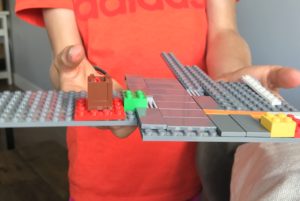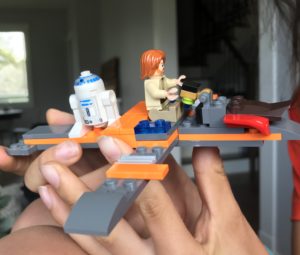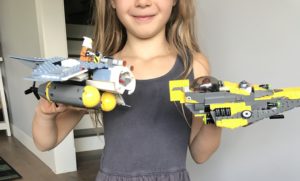Metaphors of Curriculum



Lego
COVID has created a lot of open space in my home and as a result has led to the exploration of toys long forgotten and the creation of new games. One such exploration led to the dusting off of bins and bins of Lego. Perhaps the spilling of bins all over the floor, dust billowing into the air, is a more accurate description. My daughter, having shown no interest in the past, was suddenly spending hours laying on the floor of her room creating all sorts of imaginary places and spaces along with wildly designed ships and cars. My older son, used to following the labelled instructions, the box with the desired outcome displayed in bright color planted in front of him, watched from the sidelines, glancing over once in a while but making it clear that he was invested in other activities. One morning, my son came bounding downstairs, a contraption in his hand and joy spilled all over his face. “Look mom!” Look what I built! There in his hand, a battleship of the likes I had never seen before. Enthusiastically, he began detailing each part, explaining how they worked and declaring that this creation could actually fly. Taking in a final gulp of air, he then, with pride in his voice, told me how he had built this on his own; without any instructions. The next number of days were spent creating and recreating ships, towns, and many other structures both on his own and with his sister. I would now often see the two of them laying on the floor, heads together, creating worlds that can only be conquered up through the brilliance of childhood imagination. A month later, faced with the task of describing what curriculum is, the first thing that popped into my head was Lego.
Curriculum is Lego. It arrives in a nice package, clearly labelled with the age it is suited for, a clear set of instructions inside and the outcome plastered on the outside of the box. Curriculum and Lego both contain a limited variety of sets and series, what is to be learned is decided by the manufacturer; similar to the players that determine curriculum (Blades, 1995). While at first this curriculum may seem rigid and inflexible as learners follow the instructions precisely to make just one thing, it is easy to see that the potential is there to create anything. Lego and the curriculum are both rigid and flexible, both organized and messy.
Both the rigidity and the flexibility serve me well as a teacher. They allow me to give students the freedom to explore, but also, create structure; the building of knowledge and skills. This knowledge/skill may be learnt by following the step by step instructions, by receiving help and guidance, by learning how to put the blocks together and take them apart. My daughter, while clearly engaged in playing with the Lego, built ships that consisted of a few blocks, most of the beauty was in her imagination. Conversely, my son, an experienced Lego builder, was able to take the knowledge and skills previously learnt through building with step by step instructions/adult guidance and apply them to create a complex structure.
Connected to the flexibility of the curriculum is the idea that students should be given some say within their learning. Egan (2003) discusses the beliefs of Rosseau and Dewey in connection with the curriculum in regards to “the belief that children are naturally good……[and thus] children’s own interests should be allowed to decide at least some part of what their curriculum should contain”(p13). This was shown when both my son and daughter chose to create their own curriculum by building freely without instructions or specific directions. I became the facilitator, there to help (primarily with separating blocks determined to be one), to guide if needed and to be a sounding board.
Rewind and Reflect
When I first started teaching, I had no idea of the broad knowledge I would come to have connected to curriculum. My initial plan to teach grade 4/5 forever, soon dissolved as I landed my first permanent teaching job in a K-9 distributed learning school in Langley, BC. At this school, formerly called Lochiel U-Connect, I taught every subject imaginable from grade 2-9, (oh, the stories I could tell) and assessed students in every subject area from K-9. I would say I became very quickly versed in all curriculum areas across these grade levels in a very short amount of time. As a new teacher, I found the checklists of outcomes comforting when it came to teaching and assessing student work. I also very quickly found ways to use the curriculum to help families build projects across grade levels and I realized it was okay if some of the boxes did not get ticked. In 2013, a new principal and some brainstorming led to the further expansion of our school as we added Grade 10 followed by Grade 11 and then Grade 12. Suddenly I found myself teaching high school English and as we grew further, moved locations and changed names, I became a high school teacher. Currently, I teach English (8-12), Musical Theatre (K-12) and Foods (11/12) in a blended/distributed learning environment at a school now simply referred to as U-Connect. I still like curriculum documents, I like that there is a guide for each grade, each subject area, but I have come to realize that within the structure of these documents, there is a lot of flexibility. Each bin (subject) and the pieces (curricular competencies/content) within it can be pulled apart, mixed and built in many different ways, can include voice and choice, and can be combined with content from other bins. What struck me, after reading Blade’s metaphorical analysis in “Procedures of Power in a Curriculum Discourse: Conversations From Home”, was the realization that when it comes to curriculum, I have given little, if any, thought to the powers behind the curriculum, to what is included and why. One sentence that really resonated with me was when Blade (1995) stated, “Foucault suggested to me a way to begin this journey of change: if we understand how the systems in which we live and form act to exclude and limit possibilities, then perhaps possibilities for change might be revealed (pp.129-130). I now wonder, does the current curriculum “act to exclude and limit possibilities?”
What then is curriculum to me?
So, how do I define curriculum? Egan (2003) posed some questions about what curriculum is when he stated:
At the superficial level, confusion about what curriculum is, and thus what people concerned with it should do, involves argument about whether curriculum subsumes instruction – and thus whether a student of curriculum should also be a student of instructional methods – or whether curriculum involves all learning experiences, or refers simply to a blueprint for achieving restricted objectives in a school setting, or includes the statement of objectives as well, or also the evaluation of their achievement, and so on (pp 9-10).
After wrestling with some of the ideas here, my definition of curriculum as a teacher would include the curricular competencies/content (“the what” as defined by Egan, 2003) but would include more than just that, as the instructional methods (“the how” as defined by Egan, 2003) is also important. To me “curriculum subsumes instruction” (Egan, 2003, p 9) and involves all learning experiences; the curriculum documents simply function as a guideline for the curriculum in my classroom.
Perhaps someone who is writing curriculum is only concerned with “the what” based on what it is believed students should be learning and when they should be learning it.
Perhaps a student of instructional methods is focused on “the how”.
Perhaps to ease inquiry and research, these both function well as separate entities.
But as a teacher, I cannot include only one or the other, or parts of each because what I teach, my curriculum, includes all aspects. When I now reflect back on the metaphor I chose for curriculum, the Lego, I see that this metaphor, in many ways, includes only part of my definition for curriculum. Without the teacher, without the student, it is merely a box with a fancy label, blocks and instructions. It is the sum of all of these parts that creates curriculum, that creates what one may see or experience when walking into classroom.
References
Blades, D. (1995) Procedures of Power in a Curriculum Discourse: Conversations from Home.
JCT, 11(4), 125-155.
Egan, K. (2003) What is Curriculum? JCACS, 1(1), 9-16.
https://jcacs.journals.yorku.ca/index.php/jcacs/article/viewFile/16845/15651
Great metaphor Leanne! I find it so interesting how kids play with Lego. I have a bin of it at school and it is a jumble of random parts and pieces. It is fascinating how some groups of kids have trouble with it not being an organized set without instructions.
And I totally felt that way as a first year teacher. I desperately needed the defined structure of the learning outcomes to provide the direction my students needed to go. Years later, I now understand students developmental abilities and can play with the curriculum in a more creative way.
Love the comparison of Lego to Curriculum. It is a perfect fit. Not only do teachers have clear instructions and the appropriate building blocks. They also have many options and opportunities to be creative in how those building blocks will look.